Sprouts are considered low-calorie vitamin bombs. We show the advantages of sprouts and which varieties are suitable for cultivation.

Sprouts are becoming more and more popular and are used more frequently in the kitchen. The crunchy sprouts enrich our diet, especially in winter. In this article we clarify what sprouts actually are, give an overview of suitable varieties and the health benefits that sprouts bring with them.
Contents
- What are sprouts?
- Sprout varieties: Which plants are suitable?
- How healthy are sprouts?
- Usage: Recipes with sprouts
- Store and preserve sprouts
- Are sprouts dangerous?
What are sprouts?
Sprouts, or sprouts for short, are the germinating seeds of plants. Since no light is required for cultivation, sprouts often have a light white to yellow color. The cotyledons are discernible but not fully developed. For the cultivation you only need water and a few days. In the case of sprouts, the entire plant is eaten with the root.
With a sprout glass cultivation is particularly easy. Instead of a lid, a sieve is screwed on here. This allows the seeds to be watered easily and excess water can drain away easily in the inverted jar.
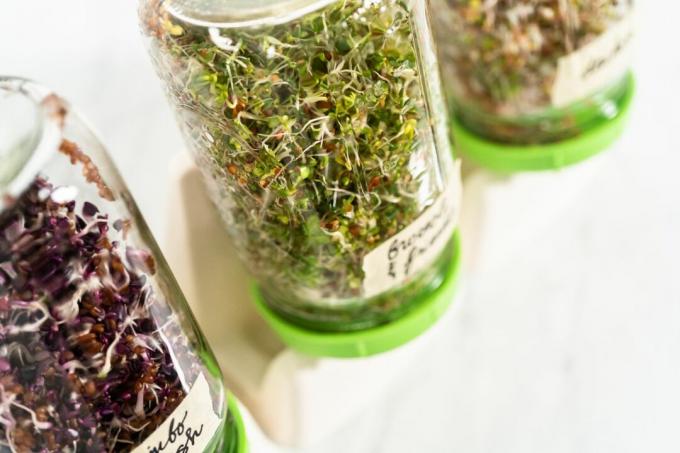
What is the difference between sprouts and microgreens?
Sprouts are at an earlier stage of development than microgreens. With microgreens, the cotyledons are clearly visible and the plants need some light to photosynthesize and get their green color. Microgreens like the classic cress are usually grown on a substrate, while sprouts do without at all.
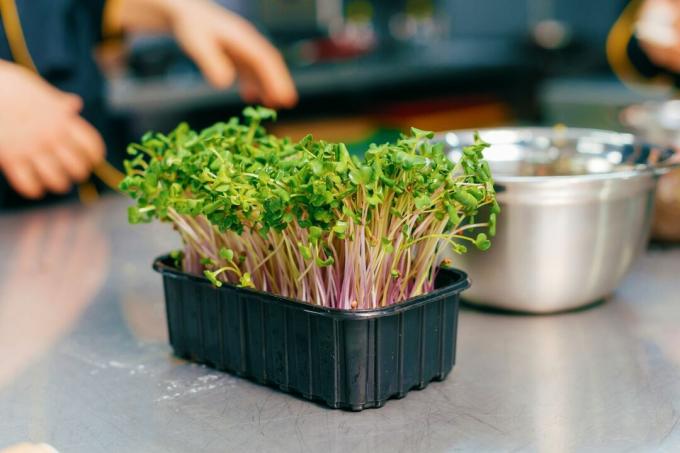
Sprout varieties: Which plants are suitable?
A variety of plant seeds are suitable for your own Cultivation of sprouts at home. Basically, you should make sure that the seeds are untreated. nightshades, such as tomatoes (Solanum lycopersicum), Paprika (capsicum)or aubergines (Solanum melongena), and other poisonous plant species are not suitable for growing sprouts.
Which plants can be grown as sprouts?
Herbs:
- borage (Borago officinalis) – should only be used in moderation
- fennel (Foeniculum vulgare) – contains a lot of potassium
- dill (Anethum graveolens)
- sesame (Sesamum indicum)
- coriander (Coriandrum sativum) – for Indian cuisine
A notice: The popular kitchen herb Borage contains some potentially toxic alkaloids. Therefore, you should only consume the plant or sprouts from borage seeds in small quantities.
Vegetables:
- Soybean (Glycine max) – contains a lot of potassium
- Lenses (Lens) – taste sweet, savory and nutty
- Peas (Pisum sativum)
- broccoli (Brassica oleracea var. italiana) – slightly spicy and very healthy
- Red cabbage (Brassica oleracea var. capitata f. rubra) – colorful reddish, but tasteless
- Mustard (Brassica napus) – spicy
- sunflower (Helianthus annuus) – mild and nutty
- Beetroot (Beta vulgaris) – colorful red
- carrot (Daucus carota subsp. sativus)
- cress (Lepidium sativum) – mild-spicy
- Arugula (Eruca sativa)
- radish (Raphanus sativus) – tastes hot and spicy
Other:
- Wheat (triticum) – mild, sweet taste
- amaranth (amaranth)
- alfalfa (Medicago sativa) – with high fiber content and lots of vitamin A
- fenugreek (Trigonella foenum-graecum) – smells similar to curry
- quinoa (Chenopodium quinoa)
- buckwheat (fagopyrum)
- Mung beans (Vigna radiata) – sweet taste
Tip: You can often find ready-made sprouts mixtures in the garden center or hardware store. It contains seeds from several plants that complement each other well in terms of taste and nutrient composition.
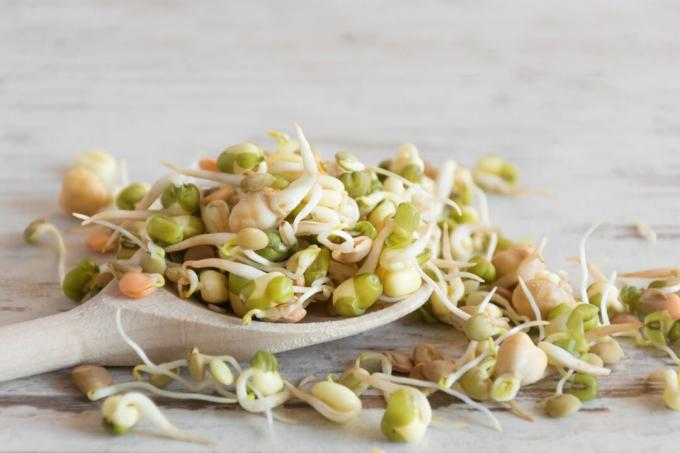
How healthy are sprouts?
In addition to a variety of nutrients and vitamins, sprouts also provide proteins, dietary fibers and secondary plant substances, which are valued for their health-promoting properties. However, the amount of these substances can vary greatly depending on the plant species and seed quality as well as the time of harvest. Sprouts generally have higher concentrations of nutrients and vitamins than mature plants. However, since they are only consumed in comparatively small amounts, they cannot be considered healthier than full-grown vegetables. As a "superfood", the role of sprouts in nutrition is currently rather overestimated. But with a diet low in vegetables, for example because the digestion does not tolerate vegetables well, sprouts are a clear enrichment of the menu.
However, in which case sprouts are not healthy, read below.
Which sprouts are the healthiest? Sprouts from many types of cruciferous vegetables (Brassicaceae), such as broccoli, kohlrabi, red cabbage or kale are particularly healthy. In addition to important nutrients and vitamins, they also contain mustard oils, which act as antioxidants in the body.
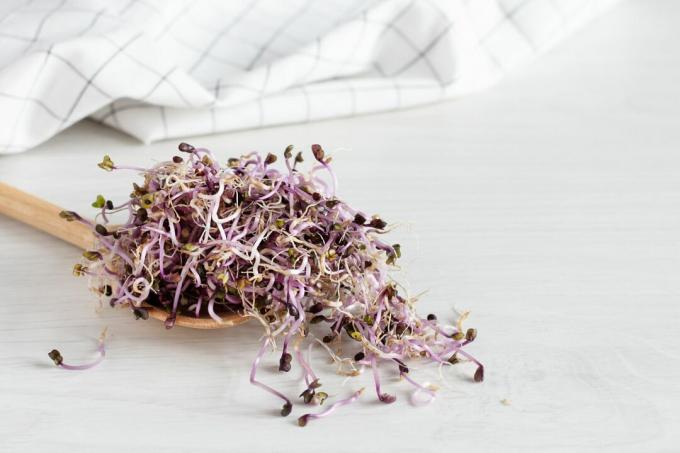
Usage: Recipes with sprouts
Sprouts are used in many ways in the kitchen. Legume sprouts, for example, go very well with vegetable dishes such as stews, spring rolls or casseroles. However, legume sprouts should be heated before consumption. Other types of sprouts can also be eaten raw without hesitation and spice up sauces, wraps, dips, salads or soups.
Which sprouts shouldn't you eat raw? Legume sprouts like soybean, lentil or pea sprouts contain phytic acid. This reduces the absorption of nutrients in the body and can cause abdominal pain. However, these substances can be rendered harmless by briefly blanching or heating directly before consumption and you can eat the sprouts without hesitation.
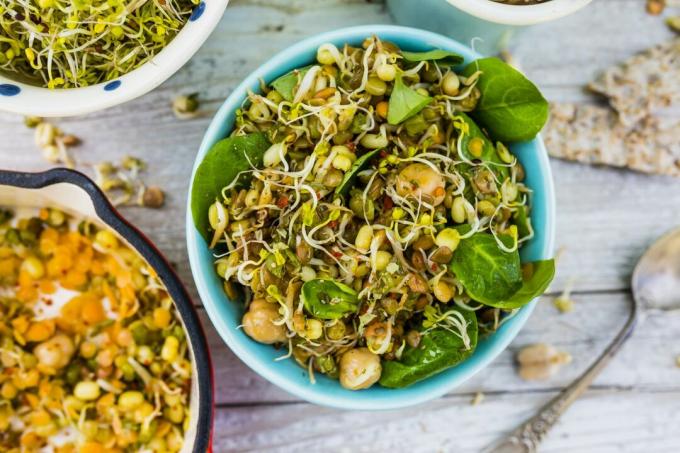
Store and preserve sprouts
The best place to store sprouts is in a sealed box in the fridge. The sprouts should be slightly damp but not wet. Since the young plants always want to continue growing, the shelf life of sprouts is generally not very long. It is best to use the sprouts fresh, as many of the essential properties are lost when they are frozen, dried or preserved. Most of the flavors and vitamins are lost when the sprouts are dried. And frozen sprouts turn into an unsavory slush when thawed. Pickling or fermenting is also possible and creates completely new tastes depending on the method.
How long do sprouts last? Sprouts should be used up after two days in the fridge at the latest. Mold and bacteria can spread quickly through the delicate fabric. When the sprouts no longer look crisp and fresh, you should discard them.
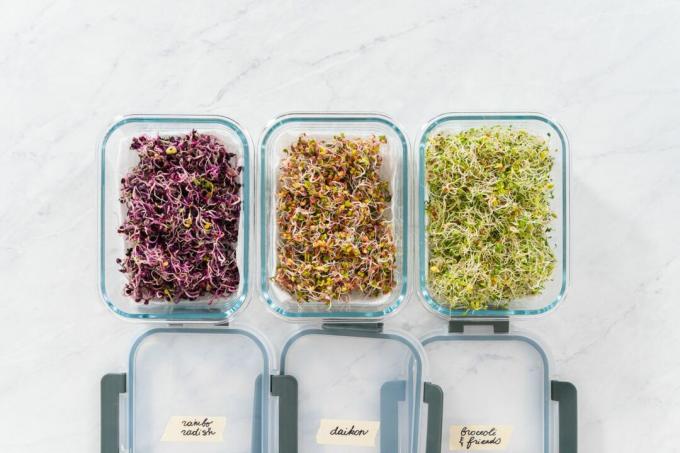
Are sprouts dangerous?
According to studies, purchased, packaged sprouts are heavily contaminated with microorganisms when the best-before date expires. There have been several outbreaks of disease in the past, believed to be due to Escherichia coli (E coli) loaded rungs were released. If in doubt, you should not eat the sprouts, especially after prolonged or improper storage.
If you are making sprouts yourself, the choice and pre-treatment of the seed is crucial. Sprouts grow in humid conditions, which also provide a good breeding ground for some microorganisms such as bacteria or mold. It is therefore important that there are no harmful pathogens on the seed. For example, non-sprout seeds may be contaminated with droppings from storage pests.
- Sprout seed is purer and less contaminated with microorganisms than normal seed.
- If you do not use special sprout seeds, you should wash them off thoroughly with lukewarm tap water beforehand.
- Clean equipment regularly and thoroughly.
- Wash your hands before planting and when handling seeds and sprouts.
If you're still in doubt, give it a try Cultivation of microgreens. These last longer because they grow on a substrate and are just as tasty as sprouts.
Register now for our Plantura garden post, secure a 10% welcome discount for our online shop and Weekly great tips, seasonal trends and inspiration for all things gardening from our expert receive.
